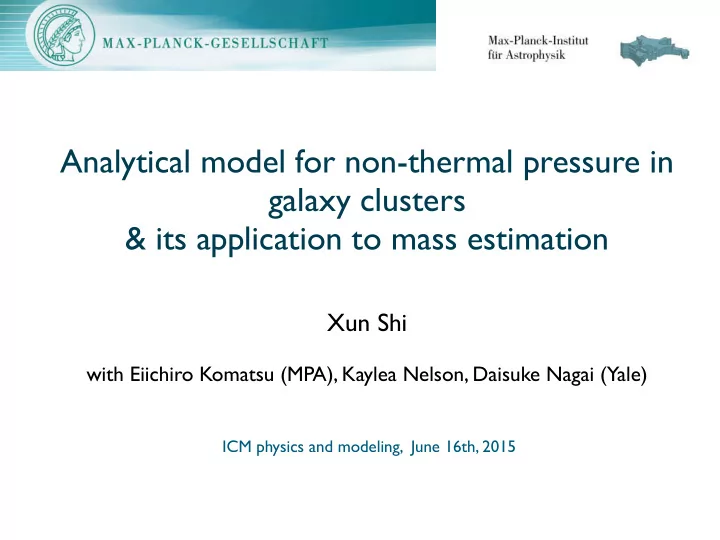

Analytical model for non-thermal pressure in galaxy clusters & its application to mass estimation Xun Shi with Eiichiro Komatsu (MPA), Kaylea Nelson, Daisuke Nagai (Yale) ICM physics and modeling, June 16th, 2015
Non-thermal pressure in galaxy clusters P rand : the major known physical Hydro simulations find contributor to the HSE mass bias kinetic pressure in the ICM - B field contribution unclear but not dominating - increasing fraction with radius - CR upper limits already tight - of order 20% at r 500 Nelson + 14 Brunetti & Jones14 P rand hard to observe (esp. at large radii where cluster masses are estimated) see Zhuraveleva and Vacca’s talks, though Evrard90, Rasia+04,12, Dolag+05, Nagai+07, Lau+09, Battaglia+12...
Analytical model for P rand Is this possible ... ? Injection Miniati13, the Matryoshka run ∇ × u 1d model of P rand Dissipation turbulent ICM Pressure ~ energy density
Our model Injection & dissipation of random kinetic energy at Eulerian positions + [Diffusion] + [Advection] average over large regions σ nth2 = P rand / ρ gas ∝ E rand per unit mass injection dissipation Shi & Komatsu 2014
Injection But WHERE and HOW ? Original source of energy: gravitational energy of infalling material 13.6 Mpc/h Vazza+2010 1e-29 1e-26 M=3 M=100 Gas density Mach number of shocked cells A previous idea: Cavaliere +11: E kin -> E th + E rand at accretion shock
Injection WHERE and HOW ? Our idea: trace the bulk of energy flow Low Mach number internal (merger) shocks process more kinetic energy x u fl injection y g r same source responsible for the heating of e n ICM, and synchronized with growth of e c gravitational potential i t e n σ tot2 = σ th2 + σ nth2 ~ T ~ ϕ i k efficiency η ≲ 1 (characteristic of weak shocks) Ryu+03, see also Pfrommer+06
Dissipation Time scale determined by the turnover time of the largest eddies - doesn’t depend on how viscosity works on small scales Lewis Fry Richardson some artist’s impression of turbulence - or a Julia set t d = β t dyn /2 “Big whorls have little whorls That feed on their velocity; And little whorls have lesser whorls And so on to viscosity” -- Lewis F. Richardson Weather prediction by numerical processes (1922)
Properties of non-thermal fraction f nth σ tot2 M t growth = ≈ d σ tot2 /dt Mdot growth rate dependence injection dissipation attractor of f nth at : radial dependence
Predicted non-thermal fraction vs simulations A mass-limited sample of 65 simulated clusters at z=0 Omega500 simulation (Nelson+14) use σ tot (r,t) from simulation as input f nth f nth sample average a few clusters faster/slower growing samples r / r 200m r / r 200m reproduce the variation among clusters both mean & scatter match; confirms the relation between f nth & growth rate note: not all relaxed Shi, Komatsu, Nelson, Nagai, 2015
From non-thermal pressure to mass bias - How well can we correct for HSE mass bias using predicted P rand ? - If we know the accretion histories, can we correct for individual clusters ? P rand depends (~10% for relaxed clusters) on the particular pipeline used for estimating the mass (since ICM has structures) mass bias the curse of derivative and division - fitting / smoothing necessary
HSE mass of rather relaxed clusters: 5-10% scatter among different methods different M500 fitting methods spline smoothing most relaxed slightly disturbed top relaxed 14/65 from X-ray mock of Omega500 clusters
Corrected mass using simulated P rand : much less biased on average most relaxed slightly disturbed top relaxed 14/65 from X-ray mock of Omega500 clusters What causes the residues? probably density structure and accelerations
Corrected mass using predicted P rand : much less biased on average, a bit more scatter most relaxed slightly disturbed top relaxed 14/65 from X-ray mock of Omega500 clusters
5-10% scatter between different fitting limits (r500 or 1.5 r500) M500 M500 On average: larger bias when fitting to larger radii (non-thermal pressure more prominent)
Correction works well for the sample mean, irrespective of methods, fitting range, or even dynamical state of the sample top 20% ‘relaxed’ top 50% ‘relaxed’ 100% of the mass-limited sample Using predicted P rand
Conclusions A physical motivated 1 d model for non-thermal pressure without free parameters, Key elements: - Infall kinetic energy converts to turbulence ( 𝜃 ) + thermal energy (1- 𝜃 ), mostly by weak internal shocks - Injected turbulence dissipates with a time scale t d ∝ eddy turnover time ∝ dynamical time Captures behaviors in hydro simulations, Improves cluster mass estimation - correcting for individual cluster seems hard due to real life complications - good for the sample mean in all cases
Recommend
More recommend